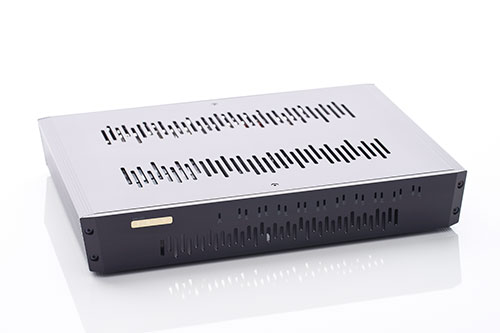The depth of the room remained the same, perhaps even slightly deeper. In terms of width, though, the musical experience demonstrated a new sense of closeness. The musicians now seemed to gather together on a tangible stage and no longer seemed to appear from some undefined location to the left or the right. The voices and instruments seemed more within grasp. All the singing seemed to gain body and substance, which I found especially impressive with the mono recordings of Ella and Louis. Kettle drums, for example, came with clearly defined contours and volume from the depths of the room. At the same time, the differentiation is clearer and more solid, far more beautiful and much neater. After lengthy listening, also over the days that followed, I consistently gained the impression that the THIXAR stands were bringing a pleasant repose to the music. They did this without the slightest sign of limiting the dynamic. On the contrary, the solidity in the music made the sound even more explosive and exciting. I had to try out something else. My music room, part of a residential building erected in 1973, has tiled floors. Footsteps come over very clearly on my system. As a test, therefore, I dropped the pick-up onto a stationary turntable and turned the volume up louder than usual. I then stamped down hard on a piece of floor I knew to be particularly sensitive. This usually results in an audible booming from the speakers. With the Silence Plus, though, the phenomenon was markedly suppressed, clear proof of the outstanding damping effect achieved by the THIXAR stand in the low frequencies.
However, there is equipment other than record players. The next thing I tried was my tube preamplifier. Although less obvious than with the turntable, similar effects were clearly noticeable here, too. In this case, the Silence Plus was my favourite. In particular, the sense of restfulness that ensued was pleasantly relaxing and improved listening enjoyment. The same was true of an experiment with my Apple Mac Mini and Antelope converter that I put on the stands together. That slightly annoying factor that often seems to be attached to digital reproduction was ameliorated. This alone would make buying a stand for a quality hi-fi set worth considering. The stands also improved the sound when placed beneath the power amplifier and the CD drive. It was always noticeable that there was greater peace and neatness in the sound, while the dynamic, even in detail, was enhanced to greater or lesser degree.
-
SOtM sNH-10G Netzwerk Switch
Wer hätte gedacht, dass meine Beschäftigung mit den SOtM-Geräten gleich zu einer Trilogie gerät. Aber dem Angebot von SOtM, auch noch den brandneuen Netzwerk Switch sNH-10G mit Clock-Modul in die Kette der SOtM-Geräte zu integrieren, konnte ich einfach nicht widerstehen. Beim Aufbau einer Streaming-Lösung wie mit dem Netzwerk-Player sMS-200ultra NEO kommt man ohne Netzwerkkomponenten nicht aus, wenn der Netzwerk-Player mit einem Medien-Server, auf dem sich die Musik befindet, verbunden werden soll. Hierzu nutzt man das…26.02.2019 -
finite elemente Cerabase compact & slimline, Cerapuc und Ceraball
Wenn es um die Frage der bestmöglichen Aufstellung für Audiokomponenten geht, scheiden sich die Geister. Doch egal ob im hochwertigen Rack oder auf dem Fußboden, wenn die Kette bereits auf hohem Niveau spielt, kann die passende Ankopplung das Hörerlebnis perfektionieren. Finite Elemente bietet zu diesem Zweck Füße in verschiedenen Ausführungen an. Im Vorwege des Tests habe ich ein ausführliches Telefonat mit Luis Fernandes von Finite Elemente geführt. Zwar war mir das den Spezialfüßen zugrundeliegende Prinzip…22.02.2019 -
AHP Klangmodule III G und IV G
Dieser Test war schon seit Jahren geplant, kommt aber dennoch gerade zur rechten Zeit: Denn während der diesjährigen High End hat AHP-Chef Andreas Jungblut das Klangmodul IV G vorgestellt, das dem III G klanglich überlegen sein soll – was ich nicht einfach so glauben muss, sondern auch hören kann. Es ist nun schon sechs Jahre her, dass ich die AHP-Feinsicherungen in fast allen Komponenten ausprobiert habe. Ich gebe gerne zu, dass ich vor Andreas Jungbluts…21.09.2018 -
Harmonix „The Base“ TB 0917 – The Music Platform
Selten habe ich einen Bericht mit so gemischten Gefühlen begonnen: Der Preis der Füße dürfte zu einer reflexartigen Verdammung des Test in einschlägigen Foren führen – von Autoren, die The Base wohl nie gehört haben. Andererseits haben mich Harmonix-Produkte nie enttäuscht: In diesem Falle wäre es nicht gut, sich an The Base zu gewöhnen, nur um sie bald zurückzuschicken. Was die nun schon bekannte, fast nicht existente Informationspolitik von Harmonix- und Hijiri-Entwickler Kiuchi-san und in…14.09.2018 -
PSI Audio AVAA C20 – Teil 2
Im ersten Teil habe ich die Technik der Bassfallen und ihre Wirkung in meinem großen Hörraum beschrieben. Da der Effekt von Maßnahmen zur Verbesserung der Akustik aber noch stärker von den aktuellen Gegebenheiten abhängig sein dürfte als der von Kabeln oder Netzfiltern, habe ich die AVAA auch noch in zwei weiteren Räumen ausprobiert. Nach den bisherigen Erfahrungen war ich sehr gespannt, wie sich zwei C20 in meinem Dachzimmer auswirken. Dies hat eine Grundfläche von etwa…03.08.2018 -
PSI Audio AVAA C20 – Teil 1
PSI Audio hat im professionellen Musik-Markt einen guten Namen.Unter Hifi-Freunden sind die interessanten Lautsprecher aus der Schweiz wenig bekannt. Ein ganz ungewöhnliches Produkt von PSI Audio ist die aktive Bassfalle AVAA C20. Auf der diesjährigen HighEnd begegnete mir PSI Audio erstmalig in der gemeinsamen Vorführung mit Weiss Engineering. Im Gespräch mit Daniel Weiss, dem Chef von Weiss Engineering Ltd, über die aktuelle Version seines vielseitigen DAC 502 Wandlers erwähnte er die Wirksamkeit des PSI Audio…30.07.2018
© 2025 | HIFISTATEMENT | netmagazine | Alle Rechte vorbehalten | Impressum | Datenschutz

























 |
|
















































































